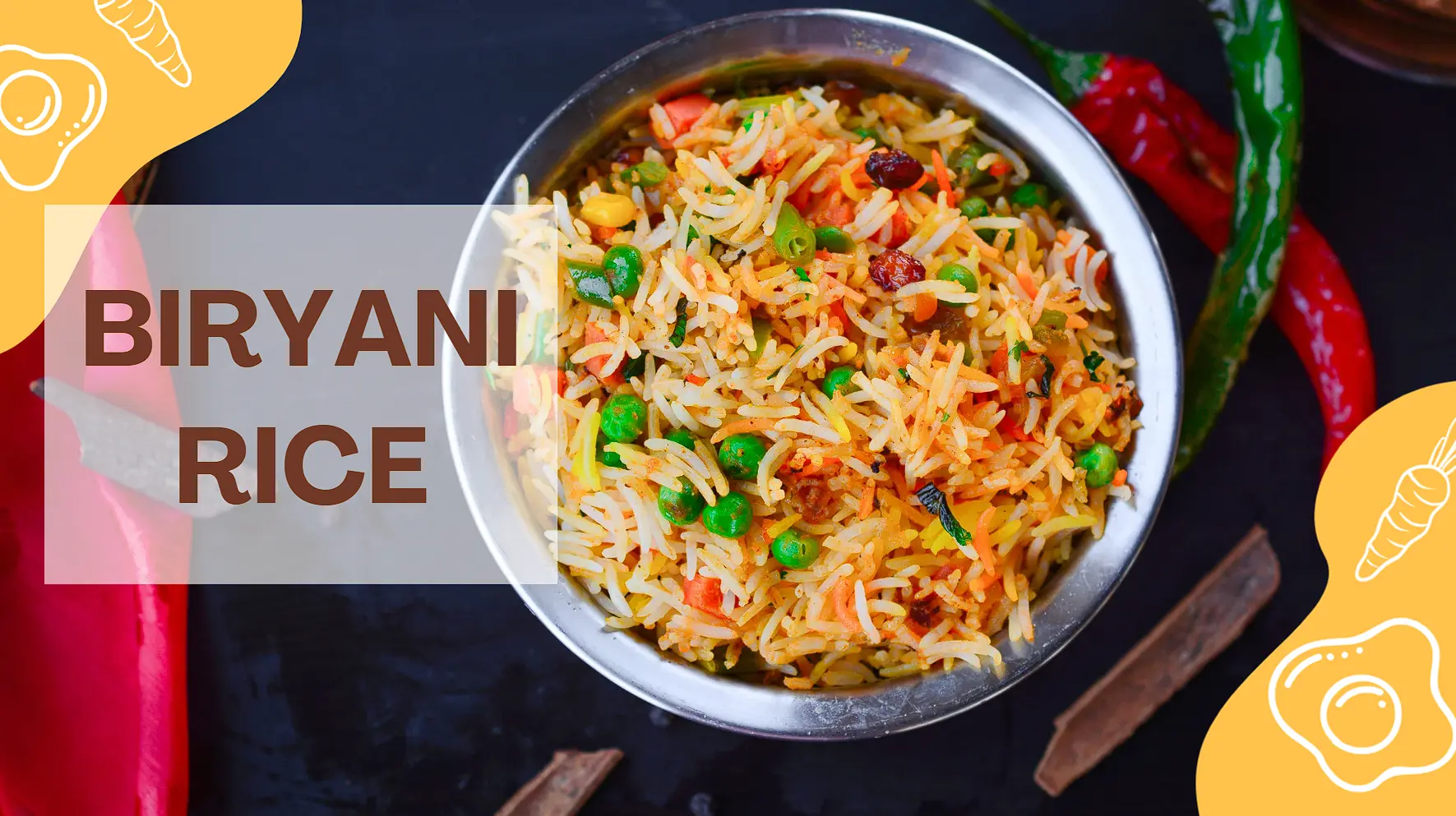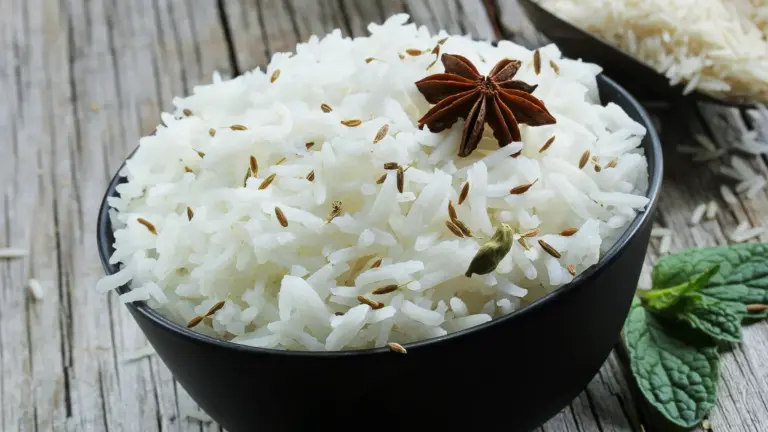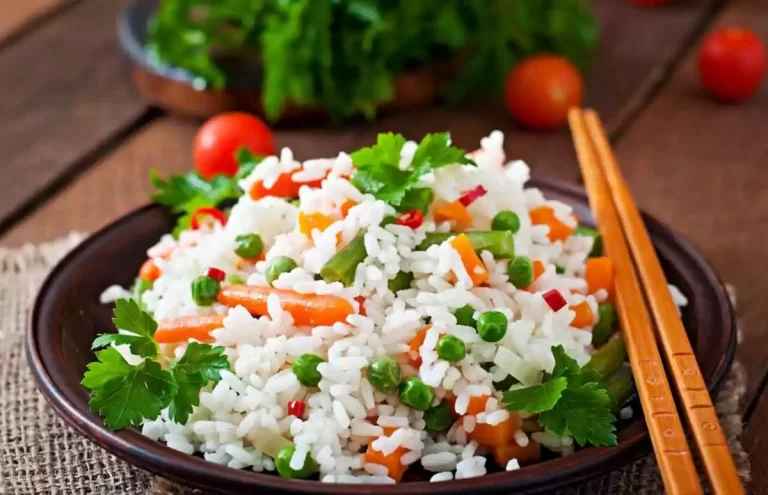Biryani Rice: A Delectable Culinary Delight

Introduction to Biryani Rice
Definition and Origin of Biryani Rice
Biryani, ah, the mere mention of this word is enough to make one’s mouth water. But what exactly is Biryani? Well, my dear readers, Biryani is a splendid dish that combines fragrant Basmati rice with an assortment of spices and meat or vegetables.
It is a culinary masterpiece that originated in the Indian subcontinent but has now spread its aromatic influence across the globe. The origin of Biryani rice can be traced back to the medieval era when it was introduced by Persian travelers to the Indian subcontinent.
The word “Biryani” itself has Persian roots, derived from the words “birinj,” meaning rice, and “biryan,” meaning fried or roasted. Over time, as different regions embraced this delectable creation, various styles and flavors of Biryani emerged.
Table of Contents
Importance and Popularity of Biryani Rice in Various Cultures
Now let’s talk about why Biryani rice holds such immense importance and popularity in various cultures around the world. Picture this: a large pot filled with layers of aromatic rice and succulent meat or vegetables cooked together over a slow flame.
The tantalizing aroma wafts through the air, captivating everyone in its vicinity. It is no wonder that Biryani rice has become an integral part of celebrations and festivities across diverse cultures.
In India alone, each state boasts its own unique version of Biryani. From the regal Hyderabadi Dum Biryani to the flavorful Lucknowi Biryan.

Types of Biryani Rice
Hyderabadi Biryani: Rich, Aromatic, and Layered with Flavors
When it comes to biryani, the Hyderabadi version reigns supreme. Originating from the royal kitchens of Nizams in Hyderabad, this biryani rice is a true masterpiece. It is known for its rich, aromatic flavors and the perfect balance of spices.
Each grain of rice is infused with fragrant spices like cardamom, cinnamon, and cloves. The meat, whether it’s tender chicken or succulent mutton, is marinated in a blend of yogurt and spices to enhance its taste.
The layers of rice and meat are cooked together on low heat for hours under a sealed lid to allow the flavors to meld together beautifully. What sets the Hyderabadi Biryani apart is the addition of saffron-soaked milk that imparts a delightful golden hue to the rice.
This regal touch gives an irresistible aroma that lingers in your senses long after you’ve finished devouring it. To top it off, fried onions and fresh mint leaves are generously sprinkled over the biryani rice before serving, adding both texture and visual appeal.
Lucknowi Biryani: Fragrant, Mild, and Cooked with Tender Meat or Vegetables
Moving from Hyderabad to Lucknow brings us to another gem in the world of biryani – the Lucknowi Biryani. Known for its delicate flavors and refined taste profile, this variation takes a more subtle approach compared to its Hyderabadi cousin. The use of fragrant spices like nutmeg and mace creates an enticing aroma that fills your kitchen as you cook.
The Lucknowi Biryani showcases tender meat or a melange of vegetables cooked with utmost care and precision. The meat is marinated in yogurt and spices, ensuring it remains juicy and tender when combined with the rice.
The rice itself is cooked separately to maintain the right texture before being layered with the meat and then slow-cooked to perfection. The result is an incredibly flavorful biryani where each ingredient complements the other without overpowering.
Kolkata Biryani: Lightly Spiced with a Hint of Sweetness, Often Contains Potatoes and Eggs
The City of Joy, Kolkata, offers its unique take on biryani – the Kolkata Biryani. This rendition, deeply influenced by Awadhi cuisine, stands out for its subtle flavors and distinctive use of ingredients.
With a lighter spice blend compared to other biryanis, Kolkata Biryani allows the natural flavors of the ingredients to shine through. What sets this biryani apart is the inclusion of boiled potatoes that add a delightful earthiness to every bite.
Additionally, Kolkata Biryani often surprises you with hidden treasures like flavorful eggs tucked away between layers of fragrant rice and succulent meat or vegetables. A touch of sweetness from caramelized onions further enhances the overall taste profile, making it an interesting variation for those seeking a milder yet satisfying biryani experience.
Ingredients used in Biryani Rice
Basmati Rice: Fragrant and Delicate
When it comes to biryani rice, one cannot underestimate the importance of using the right kind of rice. Basmati rice is the preferred choice due to its long-grain structure, which lends a unique fragrance and delicate texture to the dish.
The word “basmati” itself means “fragrant” in Hindi, and this variety lives up to its name. The slender grains elongate when cooked, ensuring that each mouthful of biryani is a treat for both taste buds and olfactory senses.
Protein-rich Meat Options
Biryani offers a plethora of options when it comes to meat choices. Chicken, mutton, beef, or seafood can be used to create protein-rich variations of this delectable dish. Each type of meat brings its own distinct flavor profile and tenderness.
Tender chunks of marinated chicken add a succulent touch while mutton imparts a rich and robust taste. Beef can provide a hearty element to the biryani, while seafood enthusiasts can indulge in shrimp or fish versions for an exquisite culinary experience.
A Symphony of Aromatic Spices
No discussion about biryani rice would be complete without mentioning the aromatic spices that infuse this dish with their enchanting flavors. Cardamom brings a subtle sweetness alongside its warm aroma; cinnamon adds a woody essence; cloves provide an earthy pungency; and saffron offers a vibrant golden hue along with its distinctive floral notes. These spices blend harmoniously to create intricate layers of flavor that dance on your palate with every mouthful.
Fresh Vegetables for Balance
In addition to meat options, vegetarians can also savor the wonders of vegetable biryani. Commonly used vegetables include onions, tomatoes, peas, and carrots. Onions, when caramelized to perfection, lend a hint of sweetness and depth to the dish.
Tomatoes add a tangy element that balances the spices beautifully. Peas contribute pops of vibrant green color and slight sweetness, while carrots offer a mild crunch and natural sweetness that complements the overall composition of biryani.
The Art of Balancing Flavors
The beauty of biryani lies in achieving the perfect balance of flavors amongst these diverse ingredients. The fragrant basmati rice serves as a canvas for the symphony of spices, meat options, and vegetables to come alive on your plate. Every grain is delicately coated with a melange of taste sensations that transport you to culinary paradise with each bite.
Biryani rice is an extraordinary dish crafted with care and precision using a combination of basmati rice, diverse meat options or vegetables for protein richness or vegetarian alternatives respectively, aromatic spices like cardamom, cinnamon, cloves along with saffron to add an enticing golden hue, and commonly used vegetables such as onions, tomatoes peas or carrots for enhanced flavor profiles. The result is a feast for the senses – an irresistible blend of fragrance, texture and taste that keeps food enthusiasts coming back for more.

Cooking Techniques for Perfect Biryani Rice
Dum Cooking Method: Infusing Flavors Slowly
When it comes to creating the perfect biryani rice, the dum cooking method reigns supreme. Dum, derived from the Persian word “dam,” meaning to breathe in steam, is a technique that involves layering rice and meat or vegetables together in a sealed pot. This allows the flavors to mingle and permeate slowly through steam cooking.
To start, you’ll need a heavy-bottomed pot with a tight-fitting lid. Begin by parboiling the rice until it’s around 70-80% cooked.
Meanwhile, marinate your meat or vegetables with an array of aromatic spices such as cardamom, cinnamon, cloves, and saffron. Layer half of the partially cooked rice over the base of the pot and then spread your marinated meat or vegetables evenly on top.
Next, add another layer of rice followed by a sprinkle of fried onions for an extra burst of flavor. Once these layers are complete, seal the pot tightly with aluminum foil or dough made from flour to prevent any steam from escaping during cooking.
Cook on low heat for about 20-25 minutes until you notice gentle steam escaping from under the lid. This slow-cooking process allows all those delightful flavors to intermingle harmoniously while ensuring that every grain of rice absorbs them completely.
Preparing Fragrant Rice: Absorption Method or Parboiling Technique
One crucial aspect of biryani rice is its distinct fragrance which can elevate your culinary experience to new heights. To achieve this aromatic delight, there are two common methods: absorption and parboiling. In the absorption method, start by rinsing your basmati rice under cold water until it runs clear; this washes away any excess starch that could make your dish sticky.
Soak the rice for about 30 minutes to ensure it cooks evenly. Meanwhile, bring water to a boil in a separate pot and add whole spices like bay leaves, cinnamon sticks, and a pinch of salt.
Drain the soaked rice and carefully add it to the boiling water. Cook until the grains are firm yet tender, then drain immediately using a colander.
The parboiling technique involves partially cooking the rice before assembling the biryani. In this method, soak the rice for around 15-20 minutes and then drain it thoroughly.
Boil water in a large pot while adding whole spices such as cardamom pods and cloves to infuse flavor into the rice. Once the water is boiling, add the drained rice and cook until it’s about 70-80% done; you should see a slight bite remaining in each grain when bitten into.
Both techniques result in fragrant, fluffy grains of biryani rice that perfectly complement your choice of meat or vegetables. The absorption method yields individual grains with distinct flavors from boiling in aromatic spiced water, while parboiling ensures that your layers cook evenly during dum cooking without becoming mushy.
Mastering these cooking techniques will allow you to create biryani dishes that burst with flavor and leave your taste buds dancing with delight. Whether you choose to follow the traditional route or experiment with your own variations, remember that practice makes perfect when it comes to achieving biryani perfection!
Regional Variations of Biryani Rice
Ambur Biryani from Tamil Nadu – Known for its unique blend of spices and tender meat.
Ambur Biryani hails from the southern state of Tamil Nadu in India, specifically from the town of Ambur. This delectable variety of Biryani is celebrated for its distinctive flavors and mouthwatering aroma.
What sets Ambur Biryani rice apart is its exceptional spice blend, which includes a combination of star anise, cinnamon, cloves, cardamom, and pepper. The meat used in this biryani is typically either mutton or chicken, marinated with a yogurt-based mixture along with ginger-garlic paste to enhance tenderness and taste.
The preparation process involves cooking rice separately until it’s almost done, then layering it with the marinated meat in a heavy-bottomed vessel. The vessel is sealed tightly to allow for slow cooking on low heat, allowing flavors to infuse perfectly into each grain of rice.
Ambur Biryani boasts a rich reddish-brown color due to the inclusion of caramelized onions and tomatoes during the cooking process. It’s served with raita (a yogurt-based side dish) and brinjal curry (eggplant curry) to balance out the spices.
Sindhi Biryani from Pakistan – Bursting with flavors from the use of yogurt and dried fruits.
Sindhi Biryani holds a special place in Pakistani cuisine as one of their most beloved regional variations. Originating from Sindh province in Pakistan, this biryani variant offers a delightful explosion of flavors on every plate.
What makes Sindhi Biryani truly unique is its vibrant combination of spices such as cumin seeds, coriander powder, turmeric powder, red chili powder blended together into a fragrant masala. The inclusion of yogurt in the marinade gives the meat a tender texture and imparts a tangy note to the final dish.
Another standout feature of Sindhi Biryani is the addition of dried fruits, such as raisins and apricots, which add a subtle sweetness to balance out the spices. The rice used in this biryani is typically basmati rice, which is cooked separately until partially done before being layered with the marinated meat.
The dish is then slow-cooked on low heat or dum for perfect flavor infusion. Sindhi Biryani is often garnished with crispy fried onions, fresh coriander leaves, and mint leaves to enhance its visual appeal and overall taste.

Malabar/Kerala Style Biriyani – Influenced by Arabian cuisine; rich in coconut flavor.
From the southern coast of India emerges an exquisite variation known as Malabar or Kerala Style Biryani. This particular style showcases a distinct Arab influence due to its geographical proximity to Arabian shores.
What distinguishes Malabar Biryani from others is its strong presence of coconut flavors intertwined with aromatic spices like cinnamon, cardamom, cloves, and fennel seeds. In this style of biryani preparation, rice is cooked separately with whole garam masalas like bay leaf and star anise for added fragrance.
The meat – be it chicken or mutton – is marinated in a special blend of spices that includes roasted coconut paste along with ginger-garlic paste and yogurt. This marinade not only tenderizes the meat but also imparts a rich coconut undertone to every bite.
The layering technique used in Malabar Biryani involves alternately placing partially cooked rice and marinated meat into a heavy-bottomed pan. The vessel is then covered tightly allowing for dum cooking (slow-cooking through steam) over low heat so that all flavors meld together harmoniously.
Malabar Biryani is often served with raita, pickle, and a side of spicy chicken or beef curry to create a fulfilling gastronomic experience. The regional variations of Biryani Rice offer a diverse range of flavors and ingredients that cater to different palates.
Whether you savor the unique spice blend of Ambur Biryani from Tamil Nadu or indulge in the burst of flavors from Sindhi Biryani in Pakistan, or dream about the rich coconut-infused Malabar/Kerala Style Biryani; each variation presents an opportunity to explore the cultural heritage and culinary delights of these regions. So, next time you find yourself craving a plateful of aromatic and mouthwatering Biryani Rice, consider trying one of these regional variations for an unforgettable dining experience.
Best Accompaniments
Raita: A Cooling Companion
When it comes to enjoying Biryani Rice, a refreshing bowl of raita is an ideal accompaniment. Raita is a traditional yogurt-based side dish that helps balance the richness and spiciness of the biryani. It provides a cool contrast to the warm and flavorful rice.
You can make raita by whisking together yogurt, finely chopped cucumbers, onions, tomatoes, and a sprinkle of roasted cumin powder. The tanginess of the yogurt combined with the crunchiness of the vegetables creates a delightful harmony with every bite.
Mirchi ka Salan: A Tangy Twist
For those seeking an extra kick of flavors, Mirchi ka Salan is the perfect choice to accompany your Biryani Rice. This delectable South Indian side dish features mildly spiced green chilies simmered in a tangy peanut and sesame-based gravy.
The combination of heat from the chilies and nuttiness from the sauce adds a unique dimension to your biryani experience. Take a bite of the fiery mirchi soaked in velvety gravy alongside each forkful of aromatic rice for an explosion of flavors.
Salad: A Fresh Crunch
To add some freshness and crunchiness to your platter, a simple salad works wonders alongside Biryani Rice. Prepare a colorful medley by tossing together chopped cucumbers, tomatoes, onions, carrots, and lettuce leaves with lemon juice or vinegar dressing. The crispness of vegetables complements the tender meat or aromatic spices in your biryani while offering essential vitamins and nutrients.
Papad: A Crispy Delight
No Indian meal is complete without papad! These thin crackers made from lentils or rice flour provide a crispy element that contrasts beautifully with the soft, flavorful rice.
Fry or roast papads until they turn golden brown and enjoy them alongside your Biryani Rice. The crunchiness and subtle spices of the papad enhance the overall texture and taste of your meal, making it a delightful addition to your biryani feast.
Mango Lassi: A Sweet Treat
To quench your thirst and add a touch of sweetness to your meal, indulge in a refreshing glass of mango lassi. Blend together ripe mangoes, yogurt, sugar, and a pinch of cardamom powder to create this heavenly drink.
The creamy and smooth texture combined with the fruity goodness of mangoes complements the bold flavors of Biryani Rice perfectly. Sip on this delightful lassi as you savor each spoonful of aromatic biryani for an extra dose of satisfaction.

Conclusion
Biryani Rice is not merely a dish; it is an experience that tantalizes all our senses. From the fragrant rice to the tender meat or vegetables cooked in layers of spices, each bite tells a story steeped in history and culture.
With its numerous regional variations and diverse accompaniments like raita, mirchi ka salan, salad, papad, and mango lassi; every individual can customize their biryani feast according to their taste preferences. So next time you have a craving for something truly special, treat yourself to the rich flavors and aromas of Biryani Rice with its perfect accompaniments.
Whether you choose Hyderabadi Biryani or Kolkata Biryani or any other regional variant; let it transport you on a culinary journey filled with excitement and satisfaction. Embrace the union of flavors in every mouthful as you revel in this timeless dish that brings people together around one table – celebrating good food, good company, and the joy of exploring diverse cuisines.
Also See:
- Discover the Power of Natural Energy Drinks: Naturally Energize
- Best High Protein Dinner Ideas for a Nourishing Meal
- Discover the Wonders of Healthy Salt: Improve Wellness
- Discover the Nutritional Power: Healthy Nuts for Optimal Well-being
- Unveiling the Art of a Lowkey Relationship: A Guide to Thriving in Discreet Love
- Ultimate House Garden Guide: Unlock the Beauty
- Unlocking the Power of Intimate Communication: Secrets & Techniques






